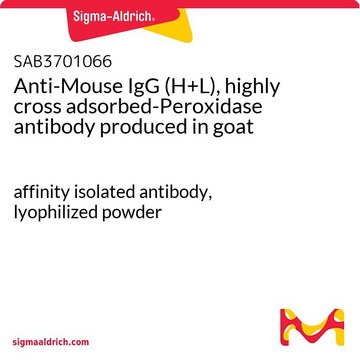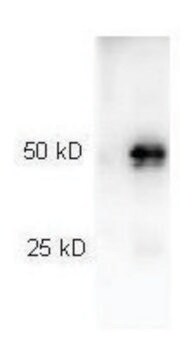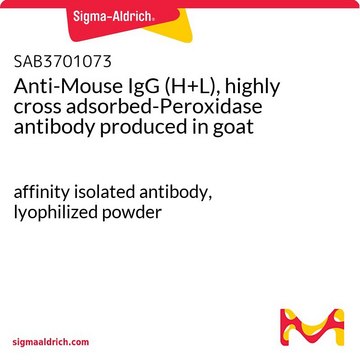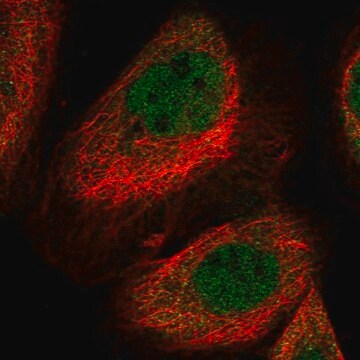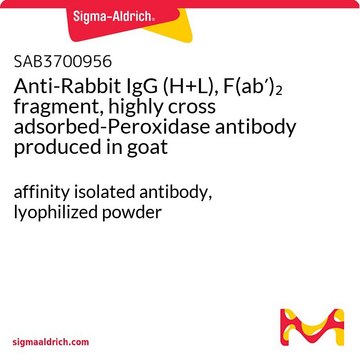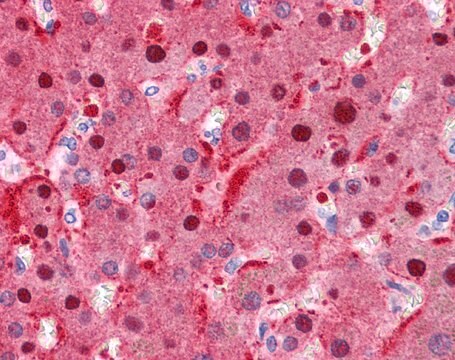SAB3700878
Anti-Rabbit IgG (H+L), highly cross adsorbed-Peroxidase antibody produced in goat
affinity isolated antibody, lyophilized powder
Synonym(s):
HRP
Sign Into View Organizational & Contract Pricing
All Photos(1)
About This Item
UNSPSC Code:
12352203
NACRES:
NA.46
Recommended Products
biological source
goat
Quality Level
conjugate
peroxidase conjugate
antibody form
affinity isolated antibody
antibody product type
secondary antibodies
clone
polyclonal
form
lyophilized powder
species reactivity
rabbit
technique(s)
immunohistochemistry: suitable
indirect ELISA: suitable
western blot: suitable
shipped in
wet ice
storage temp.
2-8°C
target post-translational modification
unmodified
Related Categories
Specificity
This product was prepared from monospecific antiserum by immunoaffinity chromatography using Rabbit IgG coupled to agarose beads followed by solid phase adsorption(s) to remove any unwanted reactivities. Assay by immunoelectrophoresis resulted in a single precipitin arc against Anti-Peroxidase, Anti-Goat Serum, Rabbit IgG and Rabbit Serum. No reaction was observed against or Bovine, Chicken, Goat, Guinea Pig, Hamster, Horse, Human, Mouse, Rat and Sheep Serum Proteins.
Immunogen
Rabbit IgG whole molecule
Physical properties
Antibody format: IgG
Physical form
Supplied in 0.02 M Potassium Phosphate, 0.15 M Sodium Chloride, pH 7.2 with 10 mg/mL Bovine Serum Albumin (BSA) - Immunoglobulin and Protease free
Reconstitution
Reconstitute with 1.0 mL deionized water (or equivalent).
Disclaimer
Unless otherwise stated in our catalog or other company documentation accompanying the product(s), our products are intended for research use only and are not to be used for any other purpose, which includes but is not limited to, unauthorized commercial uses, in vitro diagnostic uses, ex vivo or in vivo therapeutic uses or any type of consumption or application to humans or animals.
Not finding the right product?
Try our Product Selector Tool.
Choose from one of the most recent versions:
Certificates of Analysis (COA)
Lot/Batch Number
Don't see the Right Version?
If you require a particular version, you can look up a specific certificate by the Lot or Batch number.
Already Own This Product?
Find documentation for the products that you have recently purchased in the Document Library.
Customers Also Viewed
Anna Georges et al.
Scientific reports, 8(1), 15833-15833 (2018-10-28)
The ubiquitin specific protease, USP7, regulates multiple cellular pathways relevant for cancer through its ability to bind and sometimes stabilize specific target proteins through deubiquitylation. To gain a more complete profile of USP7 interactions in cancer cells, we performed affinity
Edward R Horton et al.
Advanced healthcare materials, 9(7), e1901669-e1901669 (2020-03-05)
In native tissues, the interaction between cells and the surrounding extracellular matrix (ECM) is reciprocal, as cells not only receive signals from the ECM but also actively remodel it through secretion of cell-derived ECM. However, very little is known about
Anna Georges et al.
Scientific reports, 9(1), 2724-2724 (2019-02-26)
The ubiquitin specific protease 7 (USP7 or HAUSP) is known to regulate a variety of cellular processes by binding and deubiquitylating specific target proteins. To gain a more comprehensive understanding of its interactions and functions, we used affinity purification coupled
Hu-Nan Sun et al.
Molecular medicine reports, 13(6), 4927-4933 (2016-04-16)
It has previously been reported that 16α, 17α-epoxypregnenolone-20-oxime (EPREGO) exerts an inhibitory effect on nitric oxide (NO) production and inducible NO synthase (iNOS) expression in microglia. The present study aimed to investigate the effects of EPREGO on the lipopolysaccharide (LPS)‑induced
Ashley M Campbell et al.
PLoS pathogens, 18(1), e1010235-e1010235 (2022-01-11)
The Epstein-Barr virus (EBV) BGLF2 protein is a tegument protein with multiple effects on the cellular environment, including induction of SUMOylation of cellular proteins. Using affinity-purification coupled to mass-spectrometry, we identified the miRNA-Induced Silencing Complex (RISC), essential for miRNA function
Our team of scientists has experience in all areas of research including Life Science, Material Science, Chemical Synthesis, Chromatography, Analytical and many others.
Contact Technical Service